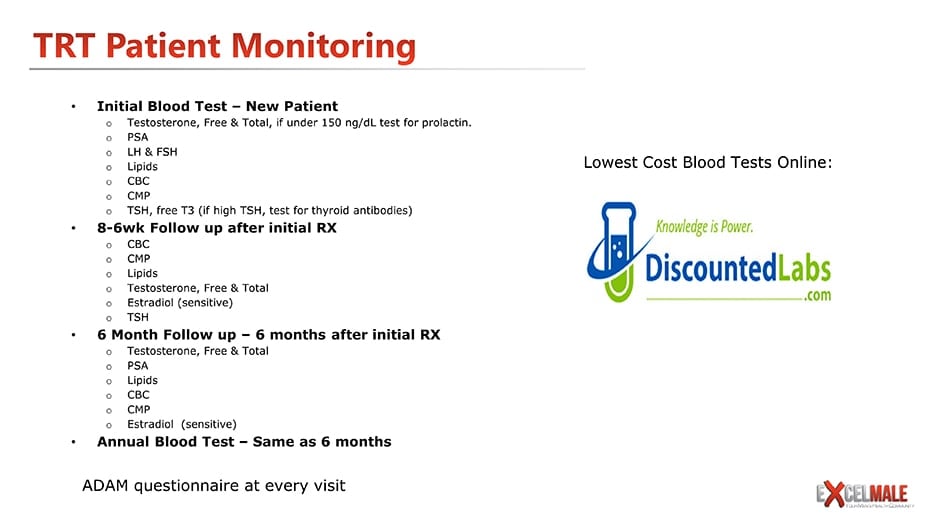Testosterone Replacement Blood Test Targets

Testosterone Replacement Monitoring Targets and Their Management
(Consult Your Physician Before Any Treatment Initiation, Cessation or Changes). These are not absolute values and should be taken into context with symptoms.
We will discuss various blood test targets for those undergoing testosterone replacement therapy (TRT). It covers key health indicators such as total and free testosterone levels, hematocrit, PSA, estradiol, blood pressure, kidney and liver function, thyroid levels, iron and ferritin levels, and cholesterol. Each parameter includes a target range and suggestions for management if the results are outside the normal range. This comprehensive approach ensures that individuals on TRT can monitor their health effectively and make informed decisions with their healthcare provider.
| Total Testosterone Test above 500 ng/dL | If low or hypogonadal symptoms are not improved, increase the testosterone dosage. High T levels (over 1500 ng/dL) with high hematocrit, low HDL, and/or side effects may require dosage reduction. |
Free Testosterone ≥ 2 % of total T |
If low, test for sex hormone-binding globulin. Higher TRT dose may increase free T by decreasing SHBG. Low SHBG may be present in diabetes. |
Hematocrit ≤ 53 % |
If high, donate blood or ask your doctor for therapeutic phlebotomy order. If low, investigate anemia or stop donating blood more than every 3 months. How to Lower High Hematocrit |
PSA ≤ 4 ng/mL |
If high, talk to your doctor about potential prostatic infection or a referral to a urologist. TRT is contraindicated if PSA is 4 ng/mL or greater. |
Estradiol (UltraSensitive Test) = 20- ? pg/mL |
Most men on TRT do not need to use an aromatase inhibitor (AI). Some physicians prescribe low dose AI for what they consider high estradiol. If low, higher testosterone dose and/or cessation of AI may be required. The lab range was derived from men with heart disease and low testosterone, so there is still debate on what the range should be for men on TRT since 0.3 to 0.4 % of testosterone aromatizes to estradiol, so men with high T due to TRT will have higher estradiol. No upper range value has been determined for men on TRT. Studies have shown that for gynecomastia to occur, high estradiol in the presence of low T and high IGF-1 may be required. Read Estradiol In Men – Why Is It Important For Optimal Health And Fitness Performance and The Top 18 Things You Did not Know About Estradiol in Men |
Blood pressure ≤ 135/85 mmHg |
If high, weight loss, exercise, T dose reduction, and/or blood pressure medications may be needed. If too low, blood pressure medication dose needs to be reduced, electrolytes checked or hypoglycemia excluded. |
Estimated Glomerular Filtration Rate (eGFR) (kidney function)≥ 60 mL/min/1.73 m2 |
If low, good hydration, use of blood pressure medications, and/or stopping offending oral supplements may improve eGFR. Exercise, high protein intake, creatine supplements, and higher muscle mass can also increase creatinine and decrease eGFR. If under 60, explore getting a Cystatin C test. |
Liver enzymes ≤ 1.2 x top value of reference range |
If high, stopping oral supplements can help. AST and ALT can increase with exercise but this is not clinically relevant. If high AST and ALT, test GGT and bilirubin to ensure no liver toxicity is present. |
TSH ≤ 2.5 U/mL |
If high, test for other thyroid tests included in a thyroid panel like free T3, free T4, and antibodies to detect hypothyroidism. Why Only Using TSH to Diagnose Hypothyroidism is Wrong |
Free T3 ≥ 3.7 pg/mL |
If low, hypothyroidism may be present. See comment on TSH. If high (>5 pg/mL), explore hyperthyroidism. |
Ferritin 55-270 ng/mL & Iron 55-160 micrograms/dL |
If low, reduce the frequency of blood donations or phlebotomies and supplement with iron until it is back to normal. If high, donate blood or get therapeutic phlebotomy. |
HDL ≥ 40 mg/dL |
The most difficult parameter to manage. Higher TRT doses decrease HDL. Niacin may help increase HDL but may cause flushing. |
Prolactin ( ≤ 30 nd/dL) |
Test if Total Testosterone is below 150 ng/dL before TRT to detect potential pituitary adenoma or other issues. High levels (> 30 ng/dL) may cause sexual dysfunction and galactorrhea in men (milk production) |
Here are panels that include these tests: Discounted Labs Panels





